|

THIS FEATURE IS IN
PROGRESS |
|
HISTORY REWRITTEN - HORTENSE,
THE GIRL, YE TOWNE CRYERS
1911-1912
|
|
You've
probably encountered
the following stories,
or a similar one, about
Hortense Oppenheimer
and her efforts to
fund a clock for
Tampa's "new" City
Hall (the one built
in 1915, now our
"Old City Hall.") |
|
Dr. Oppenheimer,
the Final Years |
The
City Council of Tampa and
Celebration of Old City Hall's
Centennial
|
|
"The
Oppenheimer children, five
daughters and a son, were no
less vigorous or gifted than
their father. Growing up in
a world filled with fine
books, music and sober
industry they found it easy
to share and to emulate
their father’s
accomplishments. Daughter
Hortense became
incensed at the city fathers
in 1914 because the
City
Hall had no tower clock to
give the proper time.
Yielding under the pressure
of
Hortense and her irate
band of ladies the mayor
erected a large
clock in the
City Hall tower
with four faces.
Inevitably, it
was named
"Hortense" and
it still keeps
accurate time
today.
You may have even
found
it right here on TampaPix, because
it's what
Dr. James M. Ingram wrote in
1977 in the
Journal of the Florida Medical
Association about Dr. Louis S.
Oppenheimer, "Culture among the
Sandspurs" and it was reprinted in the
Sunland Tribune, Journal of the
Tampa Historical Society, Vol.
3, No. 1, Nov. 1977.
|
|
At the time, the Tampa
Tribune described the new
building as “Tampa’s City
Hall Layer Cake.”
City Council, however,
did
not find the funds for the
clockworks. Hortense
Oppenheimer, the daughter of
prominent Tampa physician
Louis Sims Oppenheimer, led
the campaign by the “Town
Criers”
that raised $1,200
to help pay for the clock.
W. H. Beckwith Jewelry
Company donated the
remainder necessary to
provide the
2,840 pound,
four-faced clock, which was
built by the Seth Thomas
Company of
Vermont.
Prior to the completion
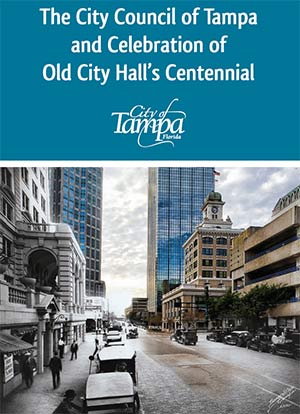 of
City Hall, the clock was
nicknamed “Hortense the
Beautiful”
in honor of its
benefactor, and it retains
this name today. of
City Hall, the clock was
nicknamed “Hortense the
Beautiful”
in honor of its
benefactor, and it retains
this name today.
Click the cover to see this
publication online.
|
|
Over the years,
these two stories,
or some similar
version or
combination of the
two, have made their
way into every telling of how
Tampa got its City
Hall Clock, who it
was named for, and
why. It is
even part of the
Historic American
Buildings Survey
report of 1981 when
City Hall was
awarded
historic building
status in 1974.
The problem is, most
details of
those stories are
false, urban legend,
myths, "fantastic
and romantic tales."
It didn't happen
quite like that. |
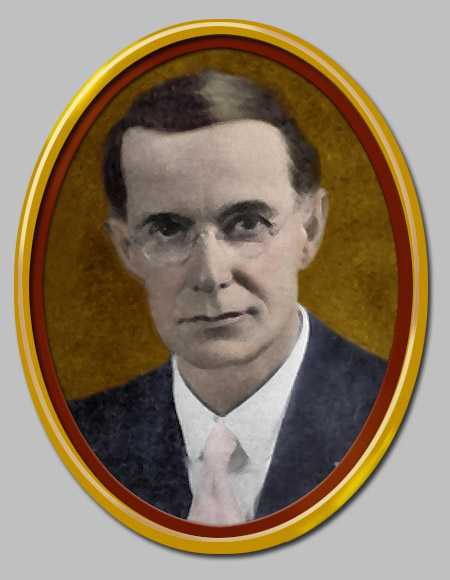
As Ernest L. Robinson
appropriately wrote
in his 1928 book,
The History of
Hillsborough County:
The City Hall, finished
in 1915, rises eight
stories, the last five
forming a tower that is
topped by a balcony and
another, smaller tower
containing a clock.
The clock, known
affectionately to city
officials and newspapermen
as "Hortense," has had many
fantastic and romantic tales
woven about it..."
CONTINUED
FROM PREVIOUS PAGE
|
CAROLINE HORTENSE
OPPENHEIMER AND THE
TOWN CRIERS
|
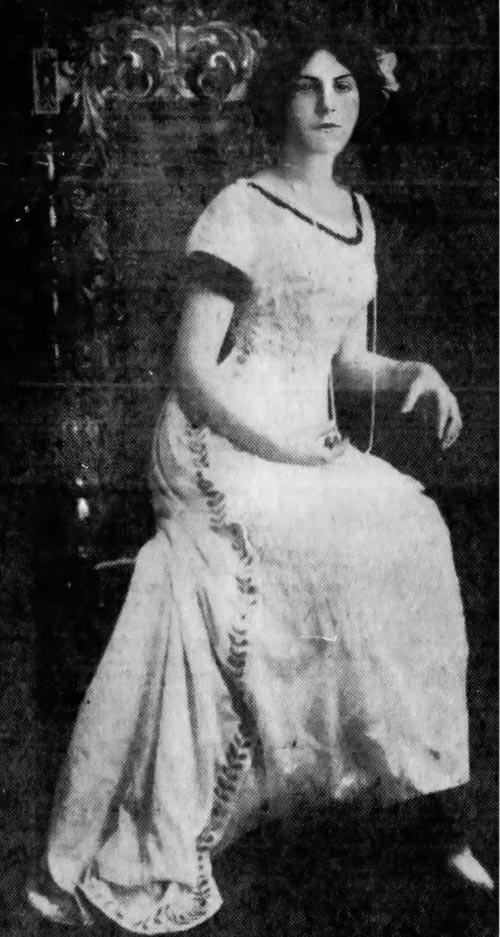 |
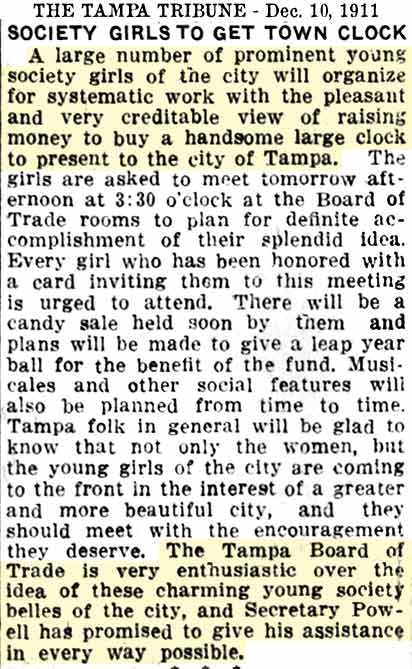 Our
history starts in
mid-December
1911, when
a large number of young
society girls
organized with the
"very creditable
view of raising
money to buy a
handsome large clock
to present to the
City of Tampa.
Invitations were
sent out to many
ladies asking them
to attend their
meeting on Dec. 11
at the Board of Trade to
organize and figure
out a way to raise
funds Our
history starts in
mid-December
1911, when
a large number of young
society girls
organized with the
"very creditable
view of raising
money to buy a
handsome large clock
to present to the
City of Tampa.
Invitations were
sent out to many
ladies asking them
to attend their
meeting on Dec. 11
at the Board of Trade to
organize and figure
out a way to raise
funds
They sought the
advice of
Willis B. Powell,
who at the time was
secretary of the
Board of Trade, who
promised to assist
them in every way
possible.
(Remember his
name, he'll be back) .
AT LEFT: Posing
in a gown worn to a
Gasparilla BalL of
an early day, Mrs.
Hortense Ford was
photographed in this
dress when she was
Hortense
Oppenheimer.
The Skinner satin
gown is trimmed with
strings of pearls
and velvet.
(Tampa Times, Feb.
7, 1966 - SHE
REMEMBERS LONG AGO
GASPARILLA)
|
|
WHY WORK FOR IT IF YOU DON'T HAVE TO?
Would anyone work to raise funds for a town clock without first going to City officials to see if they would provide a clock at their cost? It depends on that "anyone" and their intent. Did Hortense want to provide a clock as a gift for the people of Tampa? One doesn't give a gift and not pay for it or work to earn it.
Assuming Hortense did approach the Mayor or City Council first, in November of 1911 the response would surely have been that they just couldn't appropriate the funds at that time.
Maybe Hortense approached Board of Public Works and was turned down, possibly prompting Willis Powell, its Secretary, into sympathy for their cause and thus acting as their "marketing and promotions manager."
Take a look for
yourself on the
previous page what
was going on with
the City in late
1911, if you haven't
already done so.
T he the City "had bigger fish to fry,"
than a clock.
In their frying pan
were the problems of
disgraceful old City Hall, the
inadequate and
outdated water and sewer systems, the
terrible condition of Tampa's
sandy streets, and
the outdated
inadequate Lafayette St. bridge. "Sorry, we're broke" doesn't sound like the response any responsible city official would have given, but it still the same basic message.
speculation
All are logical possibilities, but all are .
The time to reveal in the circumstances of the movement in the newspapers would have been right at the beginning of the Town Criers formation, such as in the above article, or below. Something like, "Hortense Oppenheimer and friends formed the Town Criers today after her request of the City to fund a town clock was turned down due to lack of funds." But nothing like that hit the press.
It would have made a great story if it happened. But it's just not mentioned.
Maybe she did ask and it went unnoticed by the press? As you will see on the next page, from the age of around 10 or 11, "everywhere that Hortense went the press was sure to show." She was always in the news, her every move.
(Continued on next page.)
|
| |
|
| |
|
|
|


Several
young
society
girls
met at a
room at
Tampa's
Board of
Trade
on. Dec.
11,
1911, to
organize
and
figure
out a
way to
raise
funds
for a
TOWN
CLOCK.
They decided to form
a group called the
TOWN CRIERS**
with twenty-two year
old Miss Hortense
Oppenheimer as the
club president, Miss
Stella Crowell as
secretary, and Miss
Frances Chambers as
treasurer.
They met
with
Willis
Powell
who gave
them
some
helpful
suggestions.
They
decided
to hold
a sale
of
home-made
candy on
Dec. 22
and 23
at
Hortense's
uncle's
drugstore
(William
S.
Oppenheimer,
bro of
Dr. Opp.)
No more
meetings
were
scheduled
for that
year.
**The
spelling
of their
name
would
constantly
vary
from
article
to
article,
regardless
of which
newspaper
carried
the
story.
The
article
at left,
and the
one
below,
were
published
in the
same
Tribune
issue,
but each
uses a
different
spelling.
However,
a Dec.
25th,
1911
article
by the
Trib
states
they've
been
"Called
out" for
misspelling
the
group's
name,
and that
the name
is
"Cryers"
despite
it being
a
misspelling
according
th Noah
Webster. |
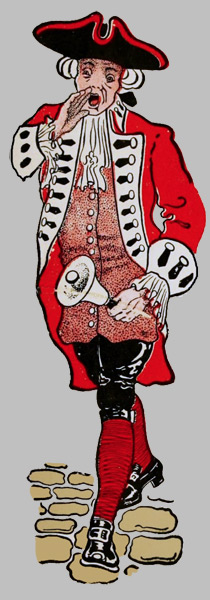 |
The
author
of the
Tribune
society
column,
Mrs.
Pauline
Browne-Hazen,
was also
the
author
of the
book
called " The
Blue
Book and
History
of
Pioneers,
Tampa"
which is
an
excellent
source
of
genealogical
information
on
Tampa's
Pioneers
and
Tampa's
history,
published
in 1915.
(See
it here at Internet Archive.)
|
Town
Crier
from a
1920
Knight &
Wall ad
at
Internet
Archive:
Rinaldi's
Official
Guide of
Tampa
Pub.
1920
Charles Van
Horn |
|
This
article
in the
Tribune
makes
reference
to the
above
article
in the
Society
section.
Powell
would be
their
"Press
Agent"
throughout
the time
the Town
Criers
were
fund
raising.
It was
Powell
who
would
send the
stories
to the
Tribune
and
Times
regarding
their
fund
raisers.
Here,
the
Tribune
has
changed
the
spelling
from
CRIERS
to
CRYERS.
The
"scaled
prices"
were
probably
a joke
by the
writer.
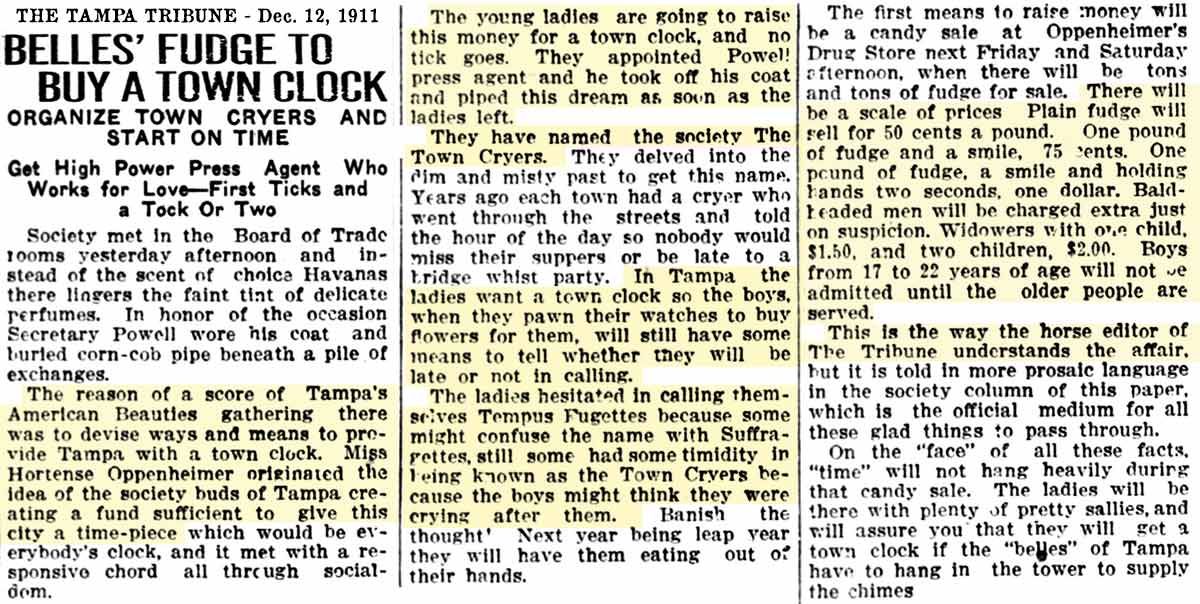
The sale
was
scheduled
for next
Friday
and
Saturday,
Dec. 22
& 23 (as
opposed
to THIS
Friday
and
Saturday,
15 &
16.)
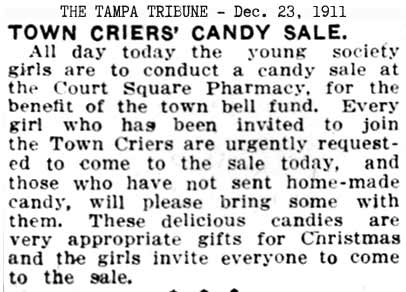
TOWN
CRIERS "TOCKED"
WHEN
THEY
SHOULD
HAVE
"TICKED"
Somebody
dropped
the ball
for the
Criers'
first
event by
not
checking
with
Oppenheimer's
drugstore as
to their
availability
for
their
candy
sale.
Seems
that
another
candy
booth
had
already
set up
there
several
days
earlier.
But
worse
yet,
some of
the
Criers
FORGOT
to make
the
candy.
They
blamed
Santa
Claus
for
this,
claiming
they
were
distracted
by the
Christmas
season.
The
article
says,
"They
were
brought
back
into the
proper
state of
mind
yesterday
by Chief
Crier
(the
Tribune
keeps
misspelling
it as "Cryer")
Hortense
Oppenheimer."
If
Hortense
was ever
"irate"
in this
whole
fundraising
campaign,
it would
have
been
right
here
with her
"fellow
Criers."
She
probably
gave
them a
proper
and
polite tongue-lashing.
The
article
assured
readers
that the
candy
would be
on sale
that
day,
Saturday,
but at
the
Court
Square
Pharmacy
instead.
Again,
two
articles
on the
same day
use
different
spellings.
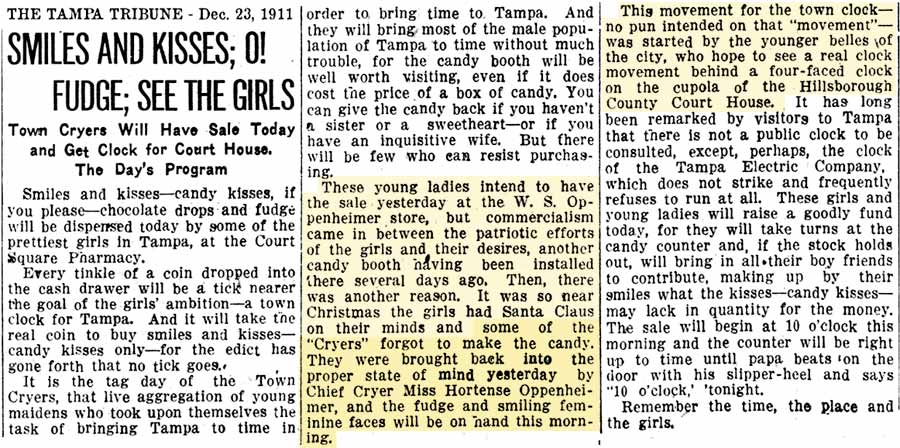
TOWN
CRIERS
LACK
ORGANIZATION
AND
SUPPORT
FROM ITS
OWN
MEMBERS,
HOW TO
SPELL
THE NAME
Early 20th -century
reporting
can
often be
rather
cryptic
at times and this
Tribune
writer's
article
was no
exception.
The
reference
to
"Thirty
wheels"
means
$30--that's
how much
they
raised
selling
candy.
You will
see that
the
Tribune
tries to
make as
many
puns as
possible
with the
subject
of time
and
clocks.
The
article
says
they
could
have
earned
more,
but the
"hands"
(members
of the
club)
failed
to show
up.
Hortense
worked a
12-hour
day
selling
candy,
from 10
a.m. to
10 p.m.
and the
only
other
member
who
spent
any
considerable
time
assisting
her was
Miss
Clara
Belle
Knott.
It says
of the
SEVENTY-FIVE
members
of the
club,
some
contributed
candy
for the
sale,
but many
failed
to make
any, so
the
candy
was sold
out.
One girl
threw up
her
hands
when it
was
suggested
she make
candy,
declaring
that she
didn't
even
know how
long to
boil
water to
make
boiled
eggs.
"It is
rumored
that
this
young
lady is
to take
a
husband
to
support
in the
next few
months--woe
be."
A
"swain"
is a
suitor
or
lover.
Also,
the
Tribune
specifically
states
that the
club
intentionally
named
themselves
the
CRYERS
even
though
it is an
incorrect
spelling.
So the
group
may have
been the
"Town
Cryers"
from the
beginning.
Later,
at a
Jan. 30,
1912
meeting,
they
change
their
name
spelling
again,
from
TOWN
CRIERS
to
YE TOWNE CRYERS.
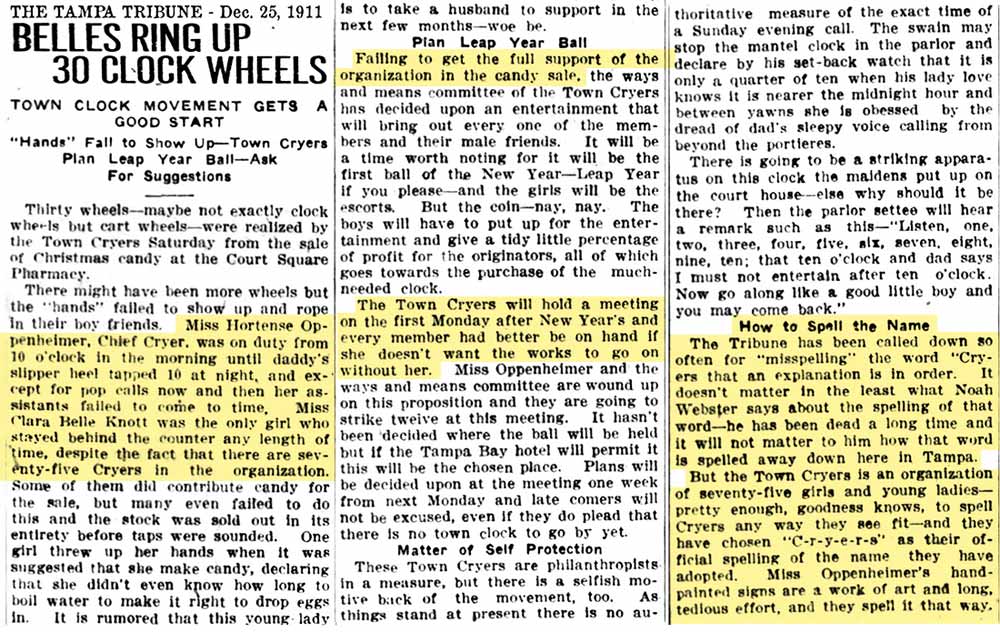
"Failing
to get
the full
support
of the
organization
in the
candy
sale,
the ways
and
means
committee
of the
Town
Cryers
has
decided
on a
Leap
Year
Ball."
Their
next
meeting
would be
the
first
Monday
after
the New
Year
"and
every
member
better
be on
hand..."
| Variations on a Town Crier, by the Tampa Tribune and Tampa Times: Dec. 12 - TRIB - First announced as "Town CRIERS" on Society page
Dec. 12 - TRIB - Detailed article - Belles' fudge to buy a town clock - "Town CRYERS"
Dec. 17 - TRIB - Short candy sale announcement (not used) - "Town CRIERS"
Dec. 17 - TRIB - Classified section short article - "Town CRIERS"
Dec. 23 - TRIB - "Smiles & Kisses.." "Town CRYERS"
Dec. 23 - TRIB - Short announcement "Town CRIERS"
Dec. 25 - TRIB - "Belles ring up 30.." "Town CRYERS"
Jan. 8 - TIMES "Town CRIERS"
Jan. 10 - TIMES - "Town CRIERS"
Jan. 16 - TIMES - "Town CRYERS"
Jan. 16 - TRIB - "Town CRYERS"
Jan. 20 - TIMES - "Town CRIERS"
Jan. 23 - TIMES - "Town CRIERS"
Jan. 31 - TIMES - An OFFICIAL name change is made at their Jan. 30 meeting.
(It's possible that they started off officially as the "Town Cryers" but the Trib had it wrong from the start as "Town Criers," because they may have thought the group wouldn't misspell "Crier" as "Cryer." But then the Tribune states they've been corrected, it is "Cryers" no matter what |
The first Town Criers meeting of 1912 announced.
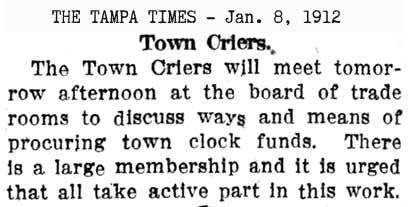 |
|
|
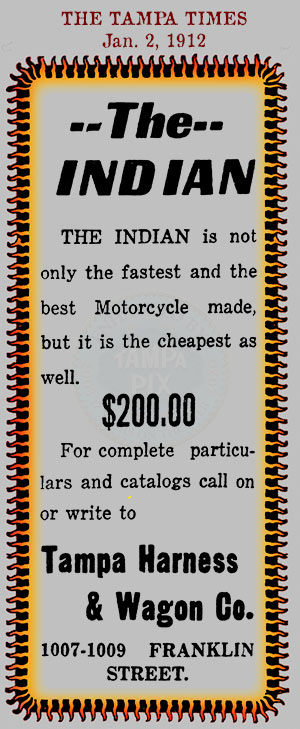 |
MOTORCYCLE
RALLY
ON
ROBERT
E.
LEE'S
BIRTHDAY
The
next
planned
fundraiser
would
be
ticket
sales
for
a
motorcycle
meet
held
by
the
Tampa
Motordrome
Racing
Assn.
The
event
would
be
held
on
Robt.
E.
Lee's
birthday,
Jan.
19th.
Motorcycle
racing
was
quite
popular
in
these
days
in
Tampa.
The
races
were
usually
held
at
the
Tampa
Bay
Hotel
Track,
what
we
call
Plant
Field
today.
The
site
was
also
used
for
the
state
fair
for
many
years.
Combined
with
Robert
E.
Lee's
birthday,
this
was
a
time
of
great
celebration
in
Tampa,
and
the
Town
Criers
planned
to
take
advantage.
Half
of
the
ticket
sales
would
go
toward
the
town
clock
fund.
Their goal
for
the
clock
fund
was
$500. |
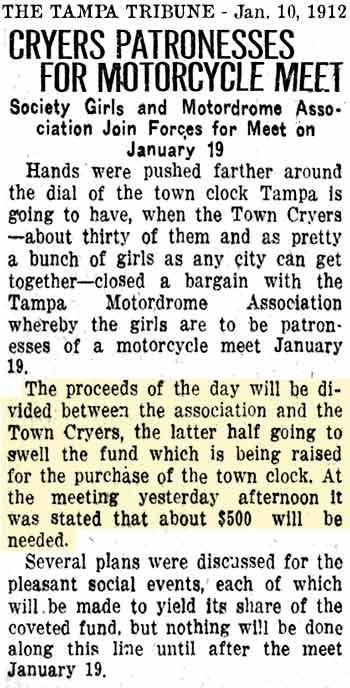 |
|
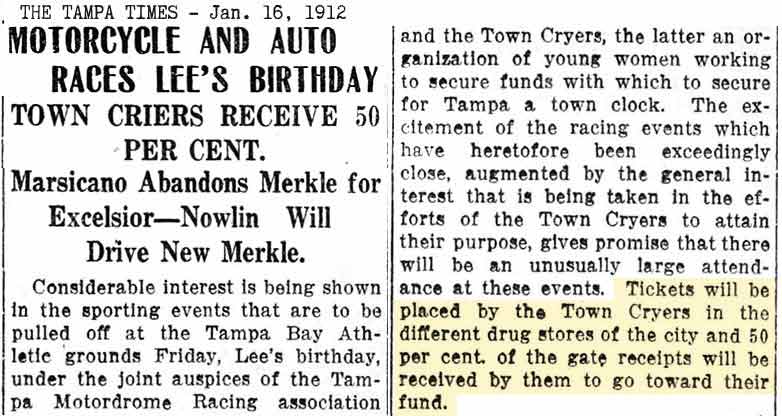 |
|
|
|
The Town Cryers
began selling
tickets for the
rally on Tuesday,
Jan. 16th.
This is the start of
the article.
Click it to read the
entire article.
The rest is about the
racers, the
motorcycles, and the
cars that were
racing.
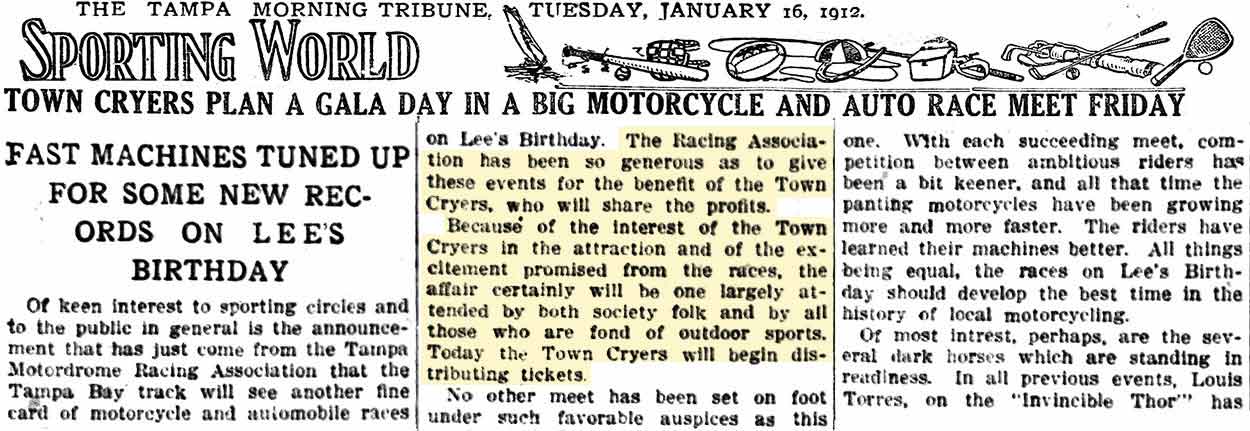 |
|
|
|
|
|
Below:
According to this
article in the Times
the next day, there
was a good crowd at
the event and the
2nd race alone was
worth the price of
admission.
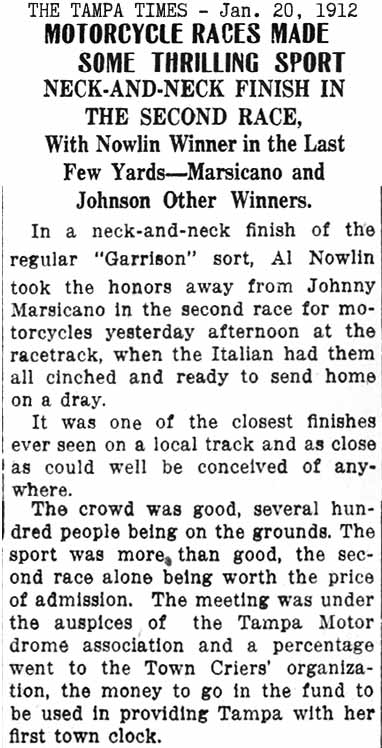
|
A LEAP YEAR BALL
At right: Next up on the
fundraising
itinerary was a
"Leap Year Ball"
to
be held on the
evening of Feb. 5 at
the Tampa Bay Hotel.
At their next
meeting, someone
suggested to have it
on Leap Day Feb. 29
but that was
rejected; it was
decided to have it
on Feb. 6th.
The ball was to be
an "invitation
affair."
Tradition goes that
on leap years, a
girl can ask a guy
to the dance.
A "subscription"
ball or dance is one
that's not open to
the general public,
one must be invited
to attend.
BELOW: The young
girls get cold feet
and don't want to
find and ask boys to
be their escort.
Apparently some were
extremely young.
|
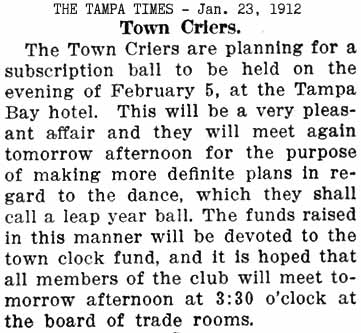 |
|
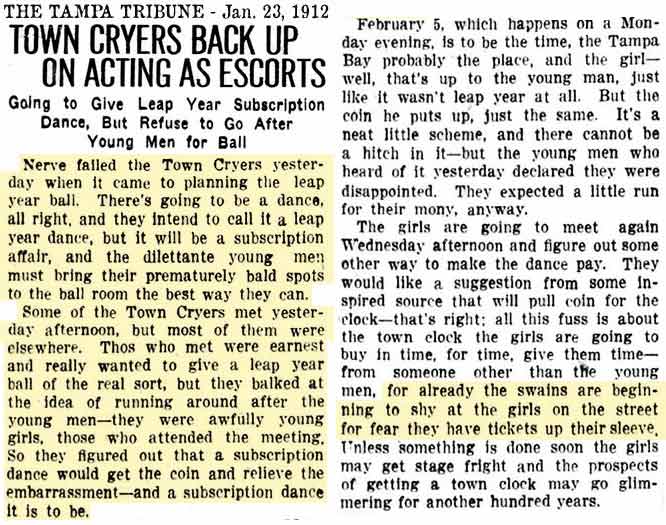
The
dance was on a
Monday night, which
was probably a
mistake that would
diminish the
turnout.
Also, boys were
beginning to avoid
having to buy
tickets, so they
were going to meet
again to see how
else they could
improve their
fundraising. |
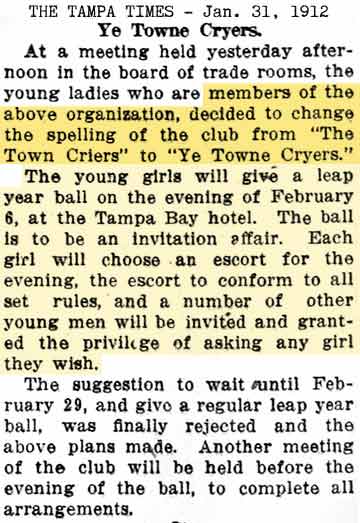
From
1920-1930.com, -
Subscription Dances
A
subscription
dance is
conducted
very
much on
the
order of
the
formal
dance,
except
that it
is
semi-public
and is
usually
held in
a public
hall.
There is
no host
or
hostess;
their
place is
held by
an
appointed
committee
or by
the
patronesses
of the
dance.
They
stand at
the door
of the
ballroom
to
welcome
guests,
and they
may
either
offer
their
hands or
bow in
greeting.
It is
the duty
of the
patronesses
to
introduce
those of
the
guests
who are
not
already
acquainted.
Each
subscriber
to the
dance
has the
privilege
of
inviting
a
certain
number
of
friends
to the
function.
Or, if
the
membership
decide
to give
several
periodic
dances,
he is
entitled
to
invite a
certain
number
of
friends
to each
one of
them.
The
invitations
are
issued
two
weeks
ahead
and
require
a prompt
acceptance
or
regrets.
Sometimes
elaborate
suppers
are
served
at the
subscription
dance,
the
money
for the
expenses
having
been
appropriated
from the
subscription
fees for
the
entertainment.
Or
simple
refreshments,
such as
dainty
sandwiches,
salads,
ices,
cakes
and
punch,
may be
served
at
small,
round
tables.
In
departing,
it is
not
considered
necessary
to take
leave of
the
patronesses.
However,
if they
are on
duty at
the
door, a
cordial
word or
two of
consideration
for
their
efforts
may be
extended.
TOWN CRIERS NAME
CHANGED
AT
LEFT: The
Town Criers met on
Wednesday afternoon
and decided to
change their name
from "The Town
Criers" to "YE TOWNE
CRYERS."
(However, this
article too could be
in error as they
seem to have been
the "Town Cryers"
from the beginning
and this was only a
change from Town
Cryers to YE TOWNE
Cryers.
It
was decided to have
the leap year ball
at the Tampa Bay
Hotel on Feb. 6, a
TUESDAY. As for
exactly who does the
asking, it was to go
both ways.
One
more meeting was
scheduled to
complete all the
arrangements. |
|
The programs for the
ball would be handed
out at the ball, as
they probably listed
the dancing
arrangements which
depended on who was
coming. Jack
Mahoney would be the
Master of Ceremonies
and would lead the
Tampa Bay Orchestra
in a grand march.
The invitations were
sent out on Feb. 2
with the girls
choosing the men,
who were expected to
call for the young
ladies but not
expected to bring
flowers or furnish
their
transportation.
Married persons were
asked to contribute
ONE DOLLAR to the
fund and single men
were not charged.
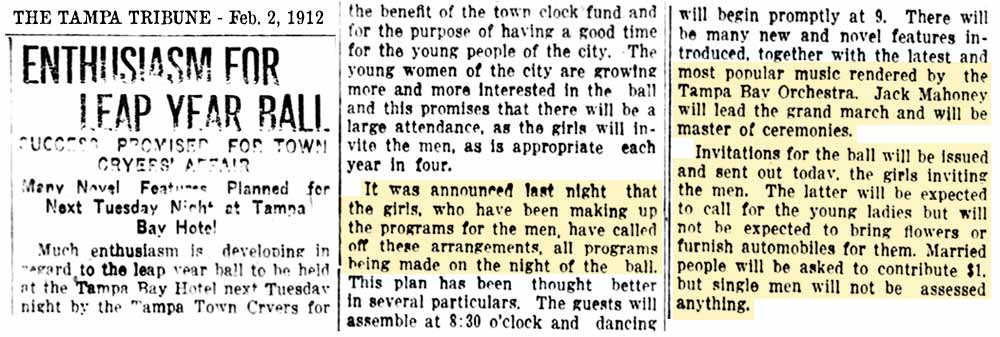
Membership in Ye
Town Cryers was now
up to 78 "young
society girls."
Invitations were
sent out to several
women friends who in
the leap year
traditional way
would escort their
husbands to the
ball. Girls
could invite the
boys to attend and
the girls could also
do the asking in
dancing.

RAVE REVIEWS FOR THE
LEAP YEAR BALL
The Times reported
on the ball the next
day, saying "last
evening was one of
the most enjoyable
of the society
events of this
winter..." It
started with a
reception from 8:30
until 9 p.m. with
the mayor's wife and
Towne Cryers
Hortense, Stella
Crowell and Frances
Chambers receiving
the guests.
Red, white and blue
programs with a
picture of a young
girl pointing to a
big clock on it were
distributed.
"Time" was the theme
for the ball. Music was provided
by the hotel
orchestra who led
off with a grand
march at 9 p.m.
headed by Hortense.
The dance numbers
were announced in
the manner of a town
crier and
consisted of over a
dozen
songs--waltzes,
ragtime, even a
Latin number was
played. The
ball room was
decorated with red,
white and blue
lights strung on
overhead wires with
dozens of alarm
clocks placed around
the wall. As a
surprise, all the
alarms rang at
midnight and
all the lights
turned off. It
was described as one
of the most
delightful events
given in quite some
time and did well to
have guests
expectantly await
the Towne Cryers'
next event.
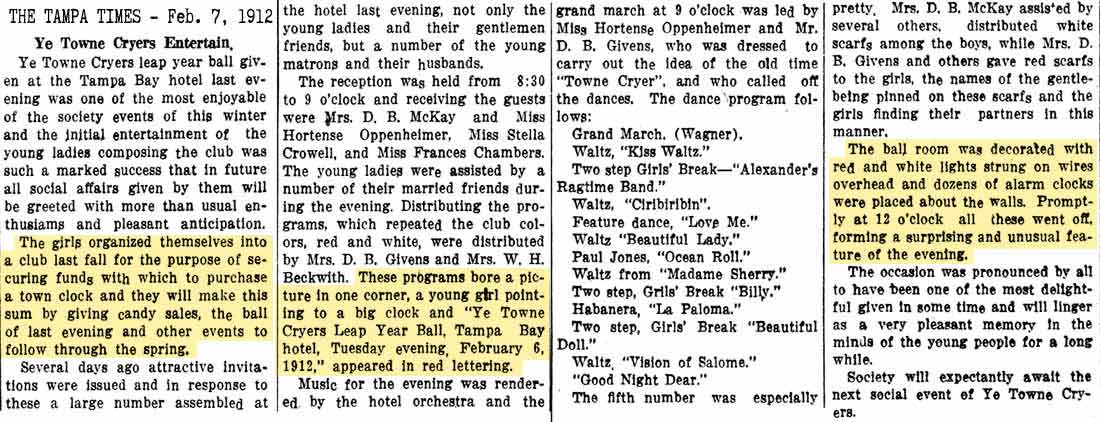
ATTENDANCE WAS
DISMAL
Even though the Leap
Year Ball was put on
in grand style, it
was not very well
attended. This
article about the
Towne Cryers' next
event, reveals at
the end that the
funds generated were
such a
disappointment that
they wouldn't even
say how much it
brought in.
A ROMANTIC
MOONLIGHT CRUISE ON
THE "FAVORITE" LINE
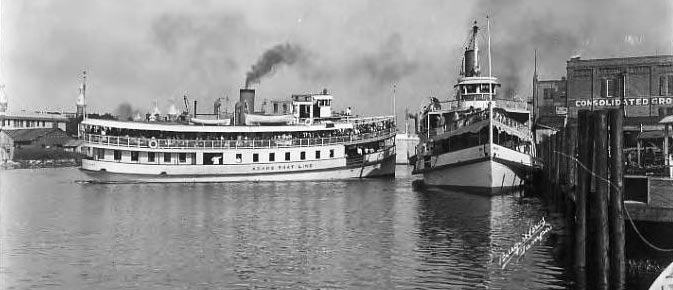
A couple of the
Favorite Line's
steamers at the
Hillsborough River
dock, 1923
Burgert Bros. photo
courtesy of the
Tampa-Hillsborough
Co. Public Library
System
|
|
NEXT EVENT: A
ROMANTIC MOONLIGHT
CRUISE ON THE BAY
The next Towne
Cryers fund raiser
would be a moonlight cruise
on a ship of the
"Favorite" line the evening of March
4th.
This
well-established
company of
steamships provided
river and bay excursions, along
with scheduled runs
between Tampa St.
Pete, and the
Manatee area.
If this fund raiser
didn't bring in a
substantial amount,
the club's prospects
of raising enough
for a town clock
would be greatly in
doubt.
"Their candy sale
brought in about
$30, but none will
tell what their leap
year ball brought
them, for it was a
disappointment."
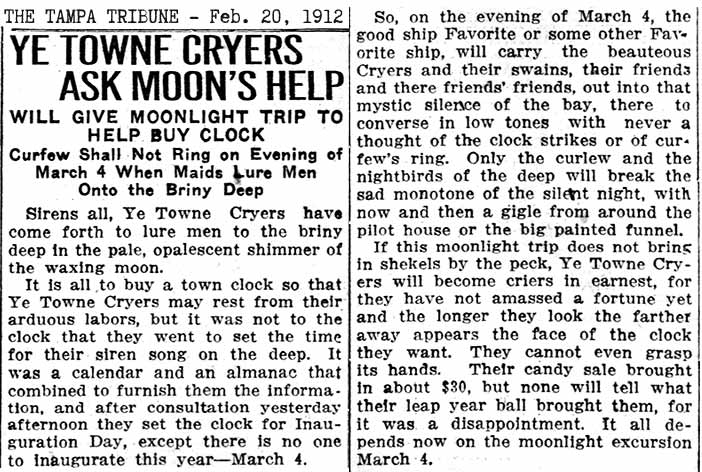
ADS FOR FAVORITE
LINE OF STEAMERS,
1911, 1912
There being no
bridge across the
bay to St. Pete, the
ferry was the only
practical method to
get there. A
drive around the bay
to the north in
those days was an
adventure. The
poor condition of
roads caused many
breakdowns, often
taking over 4 hours
to get there.
|
ROMANCE GETS THE
COLD SHOULDER
A frosty cold snap
forced the group to
cancel the event the
day before it was to
take place.

|
|
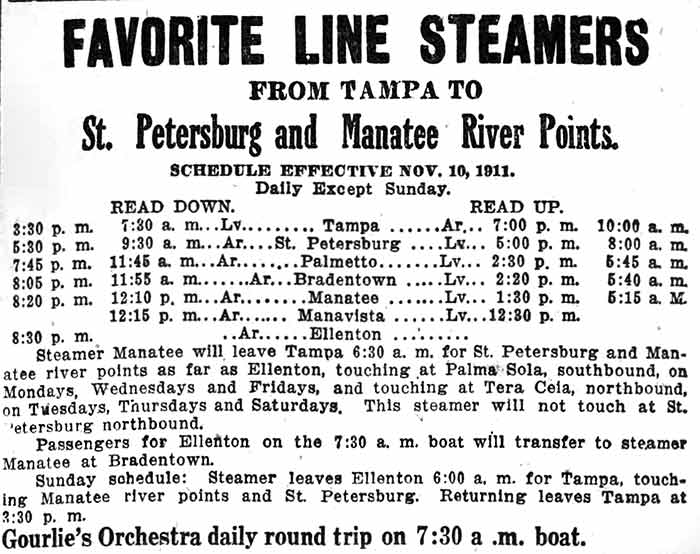 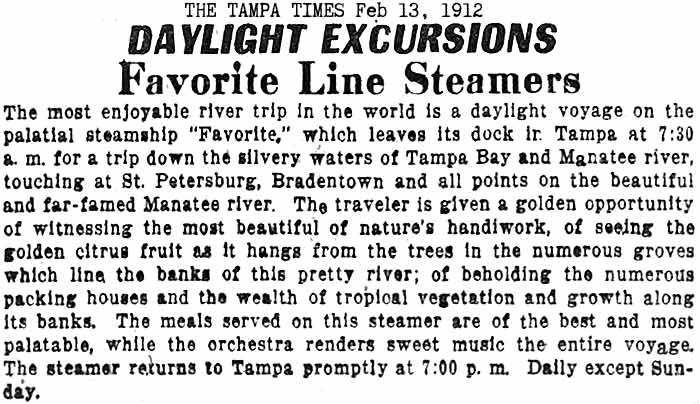 |
|
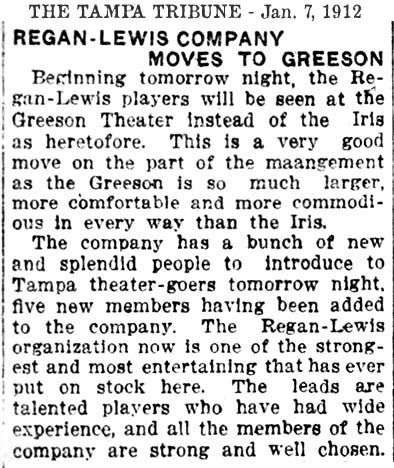 IT'S CURTAINS FOR YE
TOWNE CRYERS, WITH
NO ENCORE IT'S CURTAINS FOR YE
TOWNE CRYERS, WITH
NO ENCORE
Ye Towne Cryers' next
fundraiser would be
their last one,
something they
probably didn't
figure on at the
time. It was
billed as "a
veritable carnival
of fun and frolic
and good times" and
was a community
effort, not just the
ladies of Ye Towne
Cryers. Willis
Powell fed the Times
and the Tribune as
much hype as he
could write, so it
seems. The
event consisted of
three consecutive
evening
benefit performances,
with a matinee on
the day of the third
evening performance.
It was staged by the
Regan-Lewis Players,
a local actors
group, performing a
comedic play
entitled
"When The Clock
Strikes Twelve."
The Regan-Lewis
Players had just
moved their
performances to the
Greeson from the
Iris two months
earlier.
"This play is just
one long, happy
laugh from the
curtain on the first
act until the drop
on the last...a
light, gay, merry
farce comedy with no
other aim in view
than to make the
audience laugh and
be happy."
Local favorites were
worked into the play
to show off the best
and brightest of
their stunts.
Various specialties
by the Towne Cryers'
ladies were worked
in between the acts.
Hortense
Oppenheimer, blessed
with a beautiful
singing voice and
talent for piano,
probably performed
at one of the
intermissions.
The ladies' presence was
being used to draw
in the young men of
Tampa, "The society
girls will all be
there with their big
blue eyes and flaxen
hair; the brunettes
will have their
chance with their
sunny smile and
melting glance."
The show was
referred
to as a "Carnival"
and was playing on
Monday and Tuesday
evening, and
Wednesday in
the afternoon as
well as the evening
show.
Snacks
and refreshments
were being sold to
raise funds.
|
|
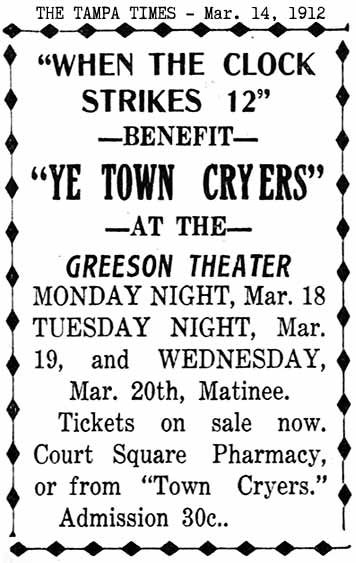
|
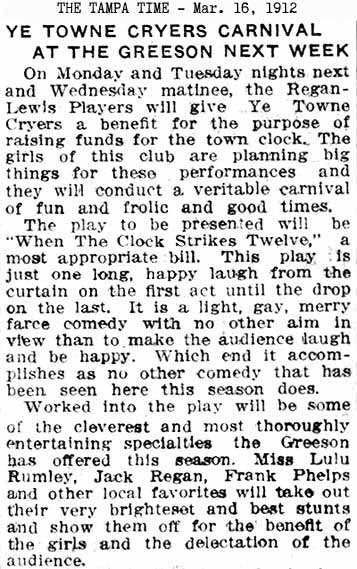 |
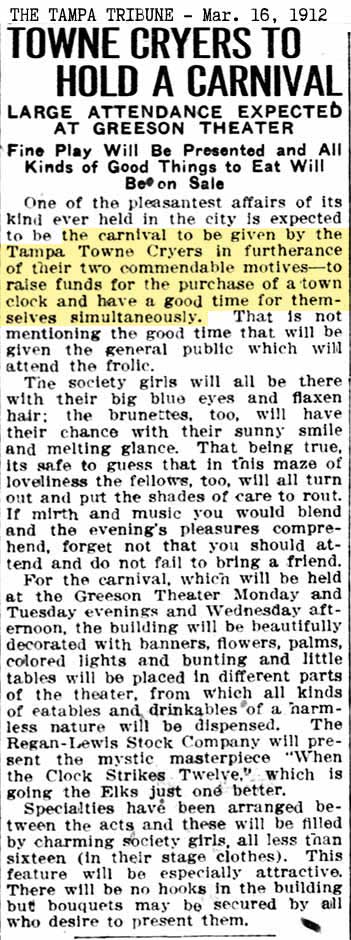 |
|
|
|
THE GREESON THEATER
The Greeson Theater
was located on the
200 block of Jackson
St. At the
time of Ye Towne
Cryers "Carnival,"
it was less than two
years old. The
theater can be
seen below to the
left of
the Bay
View Hotel, with
Jackson St. running
along the right and Tampa
St. to the left, but
by
this time it was no
longer being used as
a theater. By
1920 it was bought
by W. W. Jones and
used by Ben H. Hill
who had converted it
into three floors of
his automobile
business, selling his
"Cole 8" and "Velie
6" cars. The
first floor was
elegantly fitted and
furnished for sales
rooms and offices,
with the parts room
behind the office
out of view. The 2nd
floor contained
repair rooms
measuring 100 x 70
feet, and the 3rd
floor paint shops,
as well as storage
for cars. Cars
could drive directly
to the third floor
through the entrance
seen on the right
against the Bay View
Hotel. |
|
Feb.
25, 1926 - By this
time the Greeson was
no longer being used
as a theater.
Burgert Bros. photo
courtesy of the
Tampa Hillsborough
Co. Public Library
System.
MOUSE OVER THE PHOTO
TO ZOOM IN ON THE
THEATER.
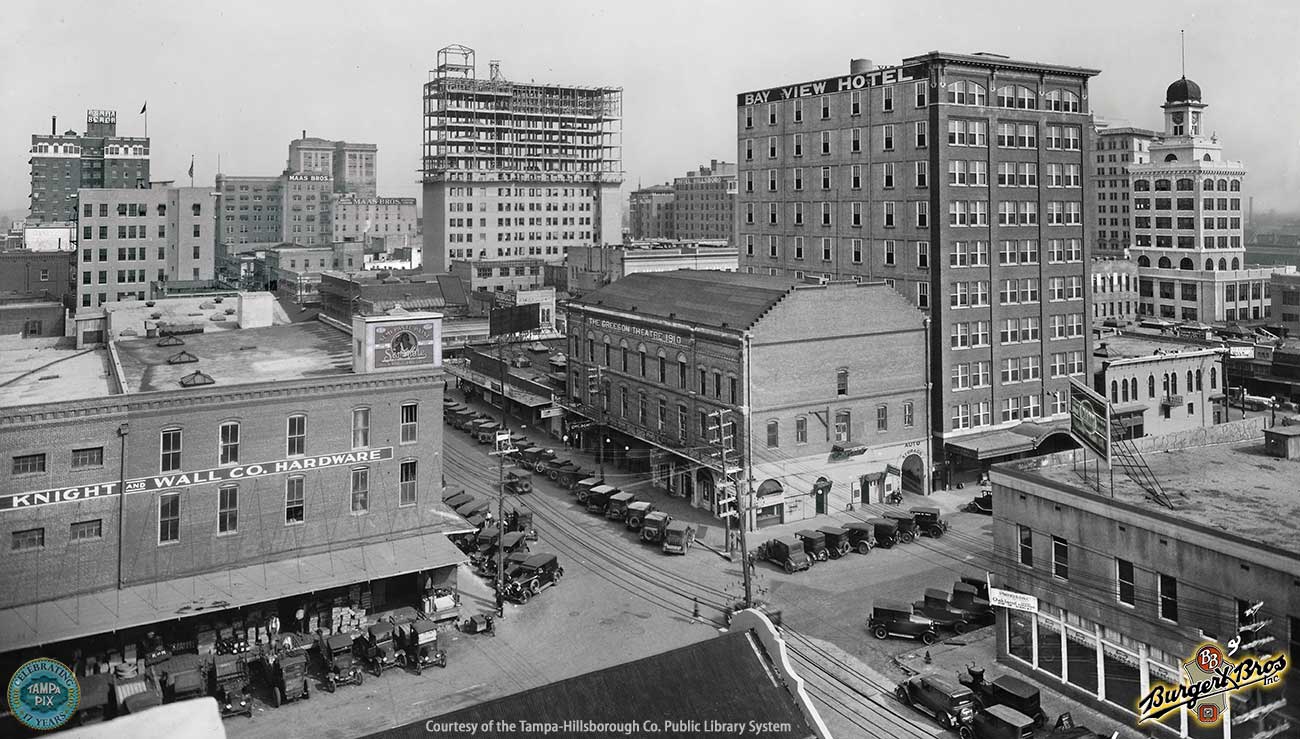
|
Plans to build the
Greeson were
announced in the
summer of 1909 by
Emmett M. Greeson, a
prominent Tampa
businessman and
former Tampa City
Council member.
It was Tampa's first
large, elaborate
theater at an
expenditure of about
$50,000. No
expense was spared
in its construction
and furnishings,
seating well over
1,000 patrons
comfortably at the
corner of Jackson
St. and Tampa St. Chelso
Peruchi, owner of a
local acting
company, planned to
lease the theater
for 10 years.
The Peruch-Gypzene
company had been
performing in a
small theater named
the "Iris."
The auditorium would
be on the 2nd floor,
with the first floor
consisting of four
large storefronts
for rent, with heavy
plate glass fronts.
There would be
balconies and
awnings in front to
give shade along the
Tampa St. side of
the walk.
The new Greeson
theater would be
ventilated on all
sides with large
folding windows so
that the audience
could step out on
balconies
surrounding the
theater. An
orchestra consisting
of "bright,
attentive young men"
would be hired to
perform.
Peruchi would make
the theater a great
success with his
careful management,
something that Tampa
badly needed at the
time.
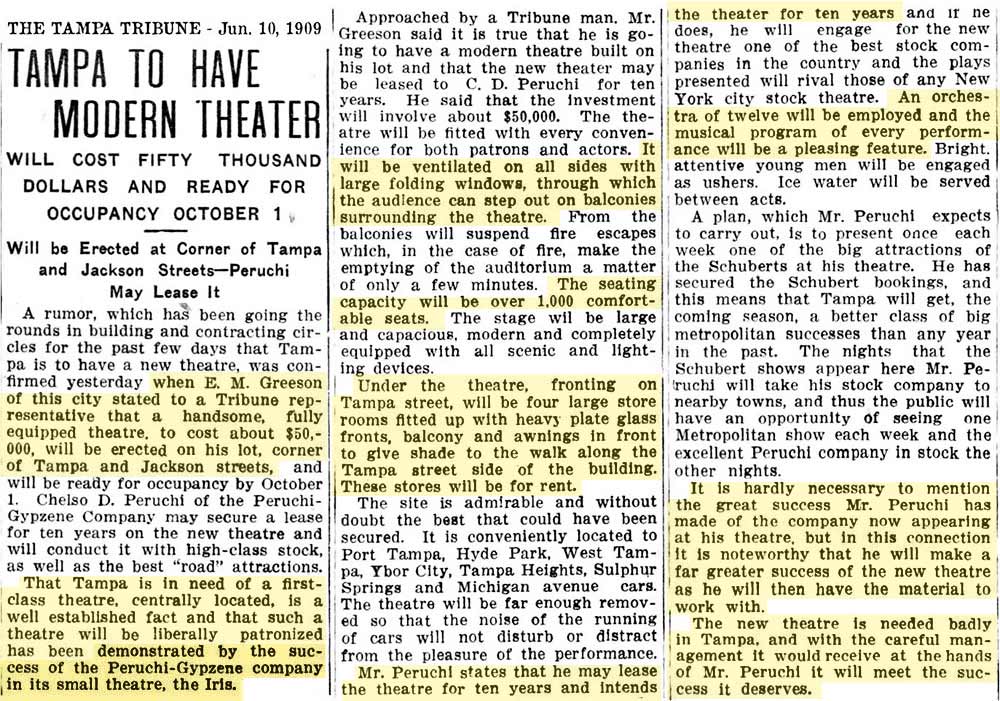
The theater opened
on June 9, 1910 to
much fanfare, with
its premier
performance of "In
the Palace of the
King."
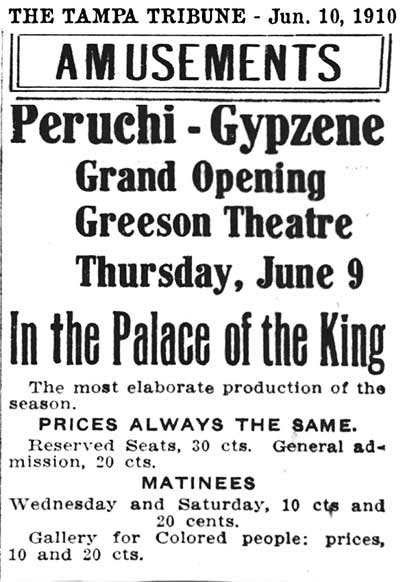
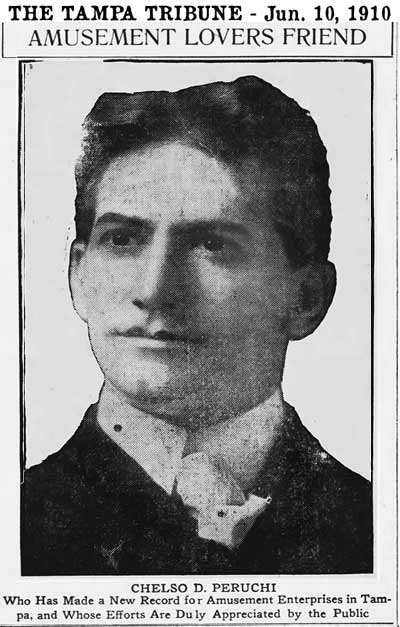
The Greeson's grand
opening on June 9,
1910 was attended by
a full house.
Chairs for the
theater had been
delayed in transit
so temporary seats
were used. The
patrons were late in
arriving,
interrupting the
first act
considerably, having
started at 8:15
instead of the
customary 8:30 p.m.
There was nothing
but praise for the
"tasteful interior"
with no details
missing. The
stage settings were
the most elaborate
ever seen in Tampa,
with the production
requiring "much
scenery and handsome
effects."
Peruchi, "as usual,
was up to the
requirements and
gave a production
that merits the
highest praise."
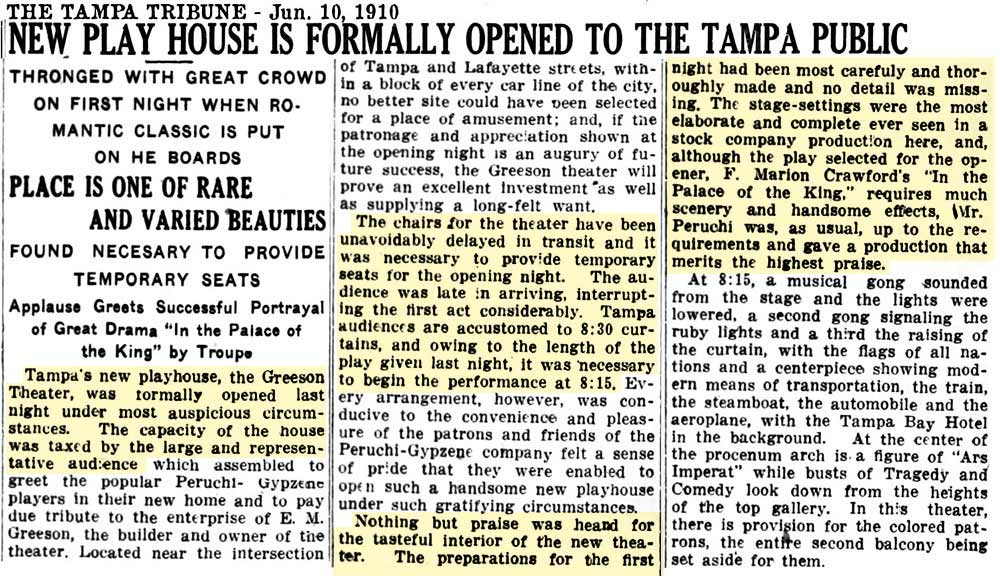
The
theater seating was
segregated, with a
separate stairway
and second balcony
reserved for "the
colored patrons."
CLICK HERE TO READ
THE REST OF THIS
ARTICLE
A DETAILED
DESCRIPTION OF THE
GREESON:
"GREESON THEATER A
FINE STRUCTURE -
Inside scheme worked
out along lines of
beauty" THE TAMPA
TRIBUNE - Jun 16,
1910
This ad was probably
placed by Dr.
Oppenheimer,
Hortense's father.
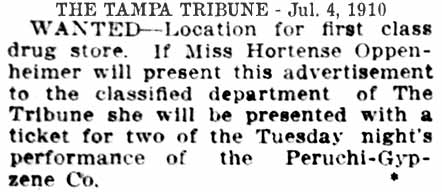
VISIT THIS BREAKOUT
FEATURE AT TAMPAPIX:
WHO WAS E. M.
GREESON AND WHAT
HAPPENED TO HIS
THEATER? |
|
|
|
|
At
right:
Ye Towne Cryers were
given free use of
the Greeson Theater.
The show ran three
times, and each day
the papers
enthusiastically
promoted the event.
There were showings
on Monday evening of
March 18, Tuesday
evening of March 19,
and a Wednesday
matinee and evening
show on the 20th.
The
play appeared to be
a raving success;
the Tribune wrote:
"The play is a very
very funny
one...decidedly one
of the cleverest
comedies ever seen
in Tampa and keeps
the audience
shrieking with
laughter for start
to finish. All
sorts of
ridiculously funny
and embarrassing
situations crop up,
and the lines that
tell the story are
unusually bright and
clever.
 |
Ye Towne Cryers
guaranteed "all
comers a good time
and especially
desire the
attendance of the
nice young men of
the city.
No leap year
foolishness will be
allowed."
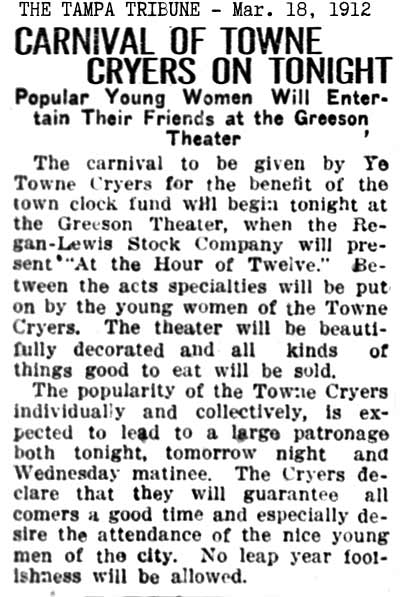
AT
LEFT: The
Regan-Lewis company
of actors had just
moved their home
performances to the
Greeson from the
Iris two months
earlier. |
This
review of the first
show says "The play
itself was
delightful and
laughable
throughout, and was
very cleverly
produced."
In
order for ticket
sales to be applied
to the town clock
fund, they had to be
purchased from the
courthouse square
pharmacy, or from
the Towne Cryers.
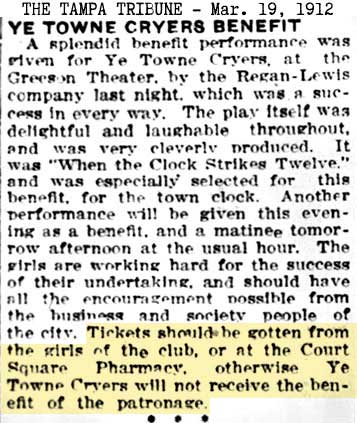 |
|
Between the acts the
Towne Cryers sold
snacks and drinks,
with one of the
actors being the
"star salesman."
"Quite a neat sum
was realized from
this source at each
of the
performances."
Did the Cryers have
to pay for the cost
of these snacks?
Nothing is said.
As
for ticket prices,
they may seem cheap,
but 50 cents back
then would be like
$13 and some change
today.
Nothing else is
written about Ye
Towne Cryers for
about two months. |
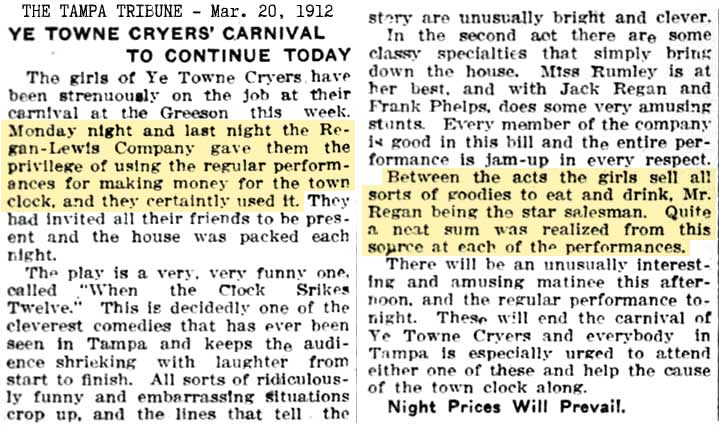 |
|
|
CATASTROPHE AT SEA
Many newspapers across the
nation published this
erroneous news on April 15,
1912
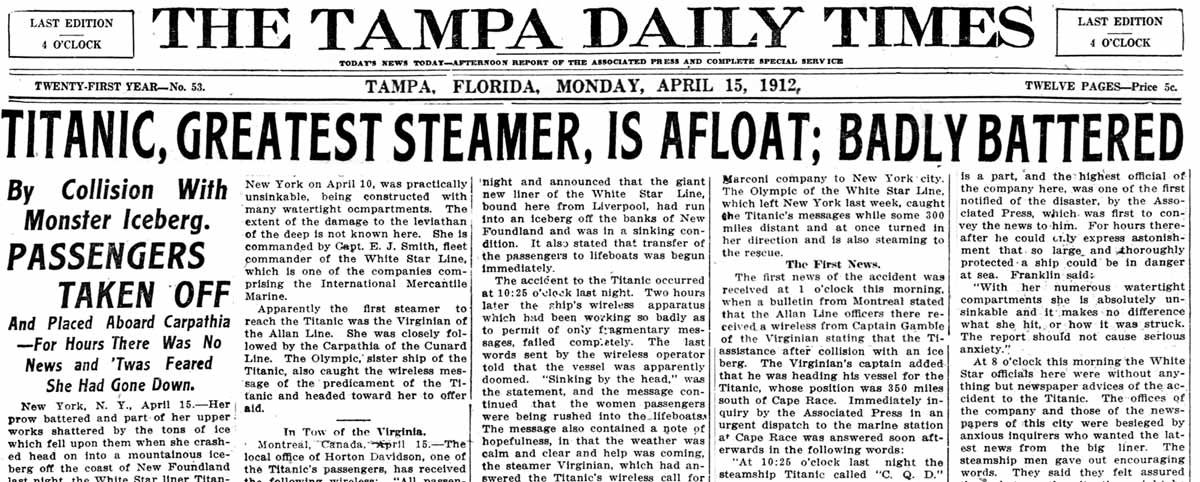
Click the
image to see the whole story
larger.
| |
|
|
TAMPA'S OLD PEOPLE'S HOME IN
DEBT
Abe Maas, who along with his
brother Isaac, were the Maas
brothers of Maas Brothers (of
course),
made a plea to the women of
Tampa to donate a dollar
toward alleviating the debt
of the old people's home, of
which he Abe was on the board
of directors. The home
charges its residents a
small amount which is not
near enough to keep up on
the running expenses and
"charitable people have to
go down in their pockets for
the balance needed."
Others on the board of
directors are named here, as
well as the women
administrators of the home.
Maas said, "There are
enough ladies in this city
who could well give a dollar
apiece to pay off this
indebtedness."
The Maas family circa
1891, Tampa
Abraham Maas with wife,
Philabena "Bena" Wolf Maas,
their son Sol Maas and their
daughter Jessie Maas.
By 1922, Jessie would marry
Jules Winston of New York,
the Winston in the 5th Ave.
NY jewelers Andrews &
Winston. Bena Wolf was
a sister of the Tampa men's
clothiers and accessories
Wolf Brothers, started
by Fred & Morris Wolf in
Tampa in 1898.
See and learn more about
these families and their
businesses,
here at TampaPix,
Photo courtesy of
Ben & Anna Maas,
great-grandson and
great-granddaughter-in-law
of Sol Maas.

 |
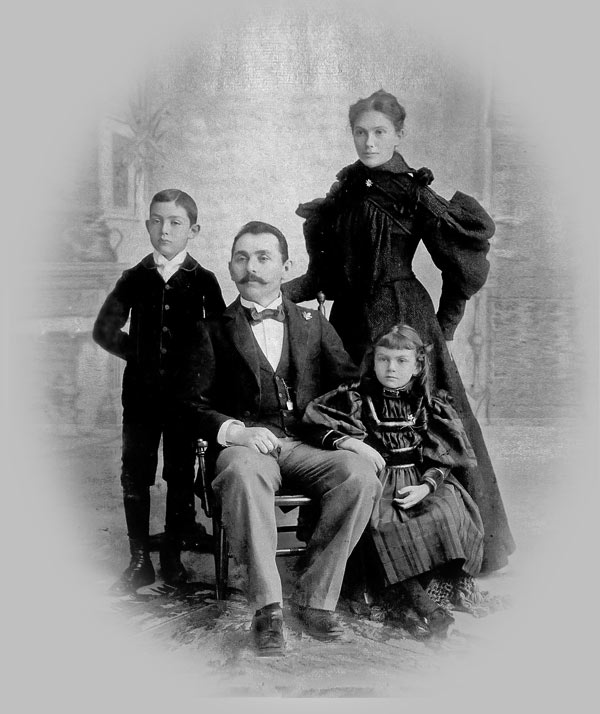 |
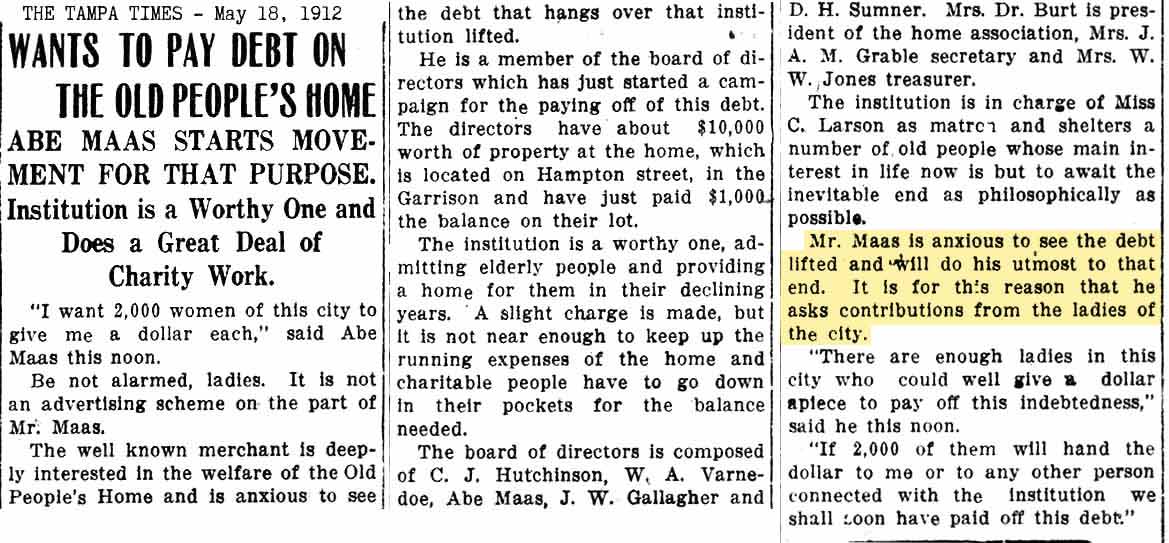
|
|
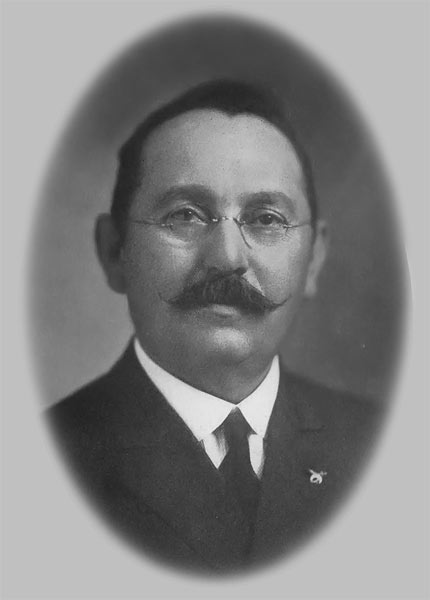 ANOTHER PLEA FOR THE OLD PEOPLE'S
HOME ANOTHER PLEA FOR THE OLD PEOPLE'S
HOME
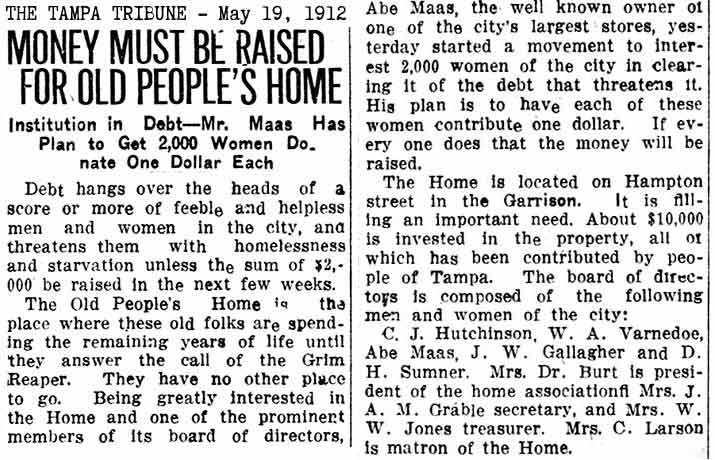 The sum of $2,000 was needed
within the next few weeks. Abe
Maas, "the well known owner of one
of the city's largest stores" is
still relying on the women of the
city to come up with the funds.
Hampton Street was in the south part
of downtown formerly occupied as
Fort Brooke, but was still a
separate municipality from Tampa at
this time. The names of the
board of directors and the women
administrators of the home are
listed again. The sum of $2,000 was needed
within the next few weeks. Abe
Maas, "the well known owner of one
of the city's largest stores" is
still relying on the women of the
city to come up with the funds.
Hampton Street was in the south part
of downtown formerly occupied as
Fort Brooke, but was still a
separate municipality from Tampa at
this time. The names of the
board of directors and the women
administrators of the home are
listed again.
Abe Maas circa 1921
From
"Men of the South, a Work for the
Newspaper Reference Library",
Southern Biographical Association,
New Orleans, 1922
|
|
YE TOWNE CRYERS
DONATE CLOCK
FUNDS
On May 30, 1912, it was announced
that
Ye Towne Cryers donated the
$150
they had in
their treasury for a town clock to
the old folks' home.
"They feel
confident that those assisting them
in raising this fund....will not
object to this disposition of the
money.
They appreciated the assistance given
them, but have decided to spend the
money for the benefit of the home in
preference to adding it for the
clock."
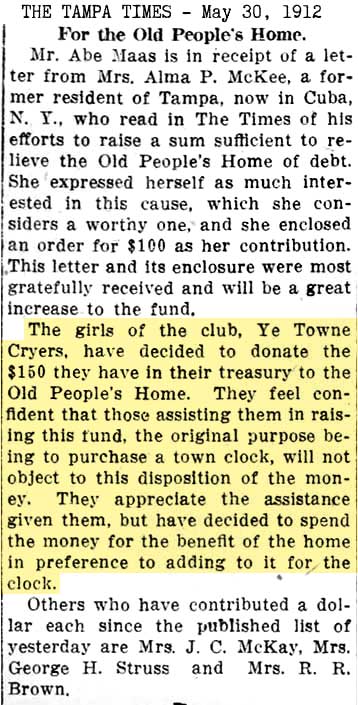
Did thei r fund raising bring i n more
than $150? Maybe. Did
they have costs that needed to be
paid off? Maybe. We just don't
know.
What we do know is that even before a new City Hall
financing plan or design was in
sight, Ye Towne Cryers felt
it would be better to help the old
people's home with the $150 they had
in their treasury.
|

This was the end for Ye Towne Cryers,
never to meet again, but not
forgotten.
|
THE FACTS:
-
Hortense and young
society girls formed
the "Town Cryers"
(or Criers) in
Dec. 1911 for
the purpose of
raising funds for a
town clock for Court
House Square.
-
Starting in Dec.
1911 they planned to
have five fund
raisers:
-
Home
made candy sale,
Dec. 23, 1911.
-
Percentage
of ticket sales for
motorcycle races,
Jan. 19, 1912.
-
Leap Year Ball at
the Tampa Bay Hotel,
Feb. 6, 1912.
-
Moonlight
cruise on the bay on
an excursion boat,
Mar. 4, 1912.
(Canceled Mar. 3 due to
cold weather.)
-
A "carnival,"
When the Clock
Strikes Twelve,
a live
comedy play at the
new Greeson Theater
with various
between-the-acts
entertainments and
concessions sales.
Evening shows Mar.
18, 19 & 20 with an
afternoon matinee on
the 20th.
-
The group ceased
activity after
the last show and was
not written about in
the papers for two
months.
-
When the old folks
home was in dire need
of funds to stay
open,
Ye Towne Cryers
donated all the
funds
they had in their
treasury, $150, to
that charity on May
30, 1912.
|
PREVIOUS
PAGE
CONTINUED ON NEXT PAGE WITH:
CITY HALL - FINANCING, SITE
SELECTION,
PLANNING,
DESIGN, CONSTRUCTION AND
COMPLETION,
WHAT ABOUT THE CLOCK?
1913-1915
|
|
|